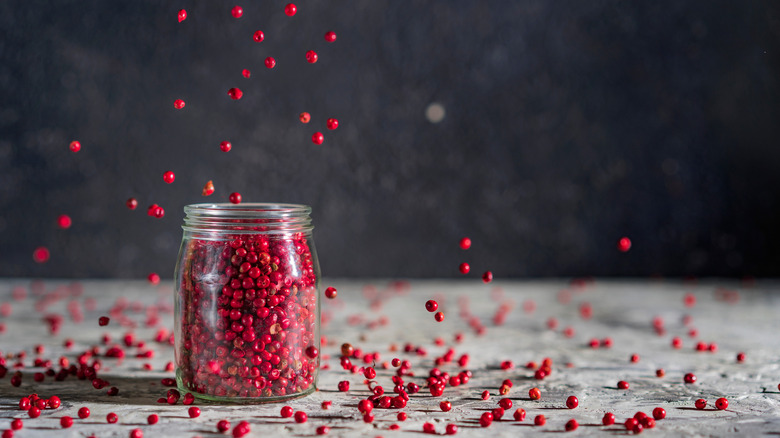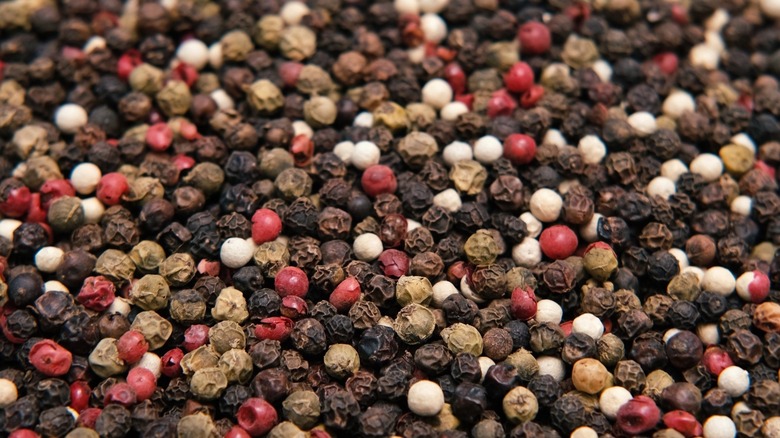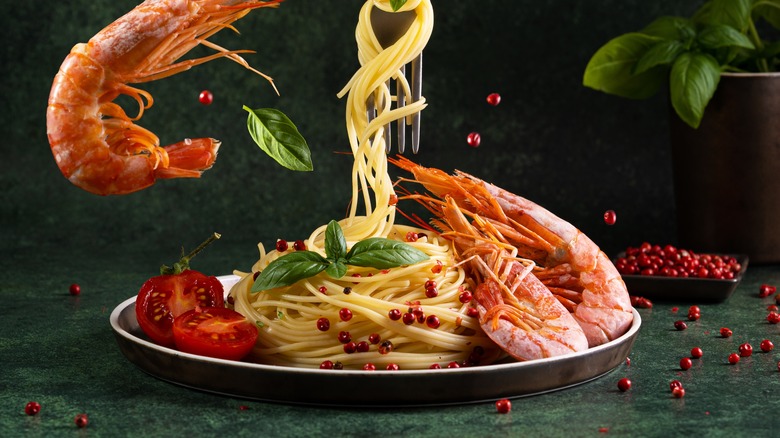Do Pink Peppercorns Taste Different Than The Black Variety?
Take a good, long browse through the spice aisle of your favorite grocery store, and things can get a little confusing. Take the extremely versatile Himalayan sea salt, for example. Most of the time, it can be used pretty interchangeably with other kinds of salt. They're all sodium chloride, after all. But what about pink pepper? It makes sense that pink peppercorns would be, well, peppercorns, but here's the thing: Not only so they have a different flavor, but it turns out that they aren't even really peppercorns.
Black, white, green, and red peppercorns are all berries from a pepper plant with the scientific name of piper nigrum. Black peppercorns are the fully ripe berries that are turned into white peppercorn when the hull is removed, red ones are overripe berries, and green are unripe. That doesn't leave much room for pink, and it turns out that those are the delicate berries of a completely different plant that goes by a few different names. It's technically called Schinus molle, but you might also hear it called the Peruvian (or Brazilian) pepper tree, or the incredibly vague-sounding South American shrub.
So, why are they even called peppercorns? In addition to looking like black peppercorns (aside from their distinctive color), they have a flavor that could be described as sort of mild black peppercorn. They are, however, very different: Pink peppercorns are also sweet, fruity, and sometimes they're even described as being floral. In other words, they're not interchangeable.
The properties of pink peppercorns differ greatly from more familiar black peppercorns
Black peppercorns — along with their red, green, and white associates — get their spicy heat and distinctive flavor from something called pipperine. It's a compound that pink peppercorns don't even have, because instead of being in that same peppercorn family, they're actually more closely related to cashews and mangoes. That starts to explain their floral, fruity taste, and there's an important thing to note here. Because they're so closely related to pistachios as well as the aforementioned cashews, they can actually cause a reaction in those who have a nut allergy.
Both pink and black peppercorns have a fascinating history and have been used for centuries to elevate different dishes. Archaeological evidence dates the use of black peppercorns to ancient Egypt (where it played a role in the mummification process), while pink peppercorns were often used by a pre-Incan society called the Wari Empire.
The light, floral, and fruity taste of pink peppercorns has sometimes been compared to lemon zest, and they're a sharp contrast to the strong, spicy kick of black peppercorns. It's worth noting, too, that they are texturally very different as well. While black peppercorns are ground with a spice grinder, the far more fragile pink peppercorns require a more delicate instrument, like a mortar and pestle.
Pink and black peppercorns have very different uses
Black peppercorns are, of course, kind of an everyday sort of pepper, and it shows: They're one of the most popular spices in the world today. When they're included in dishes, they're perfect in anything from soups and stews to salads. The closely-related white peppercorns have a slightly more earthy flavor that works well with creamy sauces and soups, while green are a more mild version of black that can serve many of the same purposes.
Pink peppercorns are often added to dishes toward the end of cooking, or used as a garnish. They work well with light dishes like seafoods and ceviche, and during the 1960s and 70s in particular, they were popularly on delicate French-inspired dishes. Their light and fruity flavor means they're perfect with chicken and poultry, on salads and in dressings, and even as a component in spice rubs, marinades, and curries.
Although you might not think of peppercorns as having much to offer in desserts, pink peppercorns definitely do. Sprinkle them on meringues, add them to chocolate, use them with a cheesecake, shortbread cookies, or even in hot chocolate. They're also pretty brilliant when added to light gin cocktails, in drinks like the Fire Breathing Dragon, in beers (such as a beer specifically designed for pairing with beer can chicken) or when used to make a simple syrupy that will bring out the sweetness of your favorite drinks. You wouldn't want to try that with black pepper!


